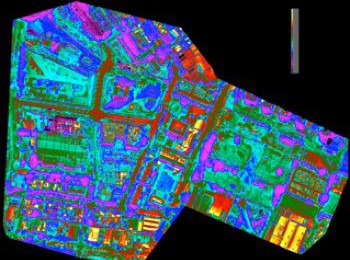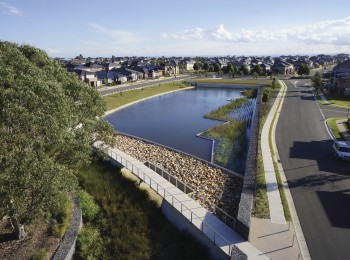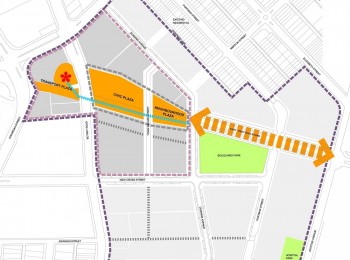Climate Resilient Places Pillar Overview
Landcom’s Climate Resilient Places pillar is focused on a leadership goal to ‘enable carbon neutral, water positive, zero waste and net positive ecological outcomes by 2028’.
Read moreRead lessThis leadership goal was developed to reflect Landcom’s contribution towards the Paris Agreement’s2, long-term goal of keeping the increase in global average temperature well below 2ºC, United Nations Sustainable Development Goals3, reducing the impact of shocks and stresses to communities and infrastructure, as identified by Resilient Sydney4 (part of the Rockefeller Foundation 100 Resilient Cities Program), such as extreme weather and water crises.
Within this pillar, Landcom focusses on environmental sustainability, and resilience. It encompasses environmental management and the adoption of independent third party rating tools and certifications, engaging with our supply chain, supporting communities to reduce their operational costs of living, and developing our projects in a way that reduce impacts on the environment.
Environmentally sustainable communities are balanced in meeting the needs of the natural, and urban environment. They take into account the needs of people today, and the needs of our future generations. Landcom also believes that the built environment should incorporate green spaces, and retain a connection to our natural habitats for the benefit of the environment, and our communities.
Landcom addresses environmental sustainability through the following focus areas:
- Energy & Emissions
- Water
- Environmental Management
- Climate & Resilience
- Waste & Materials.
Each of these focus areas includes a suite of targets to measure our success.
2 What is the Paris Agreement? (2018) https://unfccc.int/process-and-meetings/the-paris-agreement/what-is-the-paris-agreement
3 United Nations Sustainable Development Goals (2018) https://www.un.org/sustainabledevelopment/sustainable-development-goals/ for our full alignment to the SDGs see Appendix 4: Sustainable Development Goals Alignment
4 Resilient Sydney, Preliminary Resilience Assessment (2016) https://www.100resilientcities.org/cities/sydney/
| Leadership Goal |
| LEADERSHIP OBJECTIVE To deliver low carbon, resource efficient and environmentally sensitive places. |
| LEADERSHIP TARGET To lead environmental performance across Landcom developments by committing to being carbon neutral and water positive, with zero waste and net positive ecological outcomes by 2028. |
Management Approach
-
Energy & Emissions and Water
Every Landcom project is unique, and requires a bespoke approach to environmental sustainability. To identify opportunities to improve our performance for Energy & Emissions and Water targets, we use the sustainability modelling tool PRECINX.
Landcom commissioned the development of PRECINX in 2009, as a tool for quick, easy and accurate predictive modelling of greenhouse gas emissions, water consumption, transport outcomes and cost of living impacts of development in the built environment. Landcom now licenses the tool, as do many other developers, utilities, and local and state government organisations.
Our approach to Energy & Emissions includes influencing the reduction of greenhouse gas (GHG) emissions (stationary and transport) at a precinct scale across our communities, and influencing the onsite production of renewable energy. We approach Water in a similar way, by looking at the reduction of potable water use across a precinct, and identifying opportunities for recycling and reuse.
In addition, we also set ourselves targets for maximum stormwater discharge pollutant loads from our sites. This minimises downstream water quality impacts in the communities we develop. Urban stormwater modelling software such as MUSIC5 is used to measure pollutant loads across our projects.
To see our FY18 performance for Energy & Emissions, see Energy & Emissions Performance Results below, or for Water see Water Performance Results below.
5 MUSIC Overview (2018) https://ewater.org.au/products/music/music-overview/
-
Environmental Management
As part of our Sustainable Places Strategy, we are committed to adopting independent third party rating tools and certifications, or exceeding regulatory requirements. We believe it is important to have independent verification of our sustainability performance. This is aligned to our targets for Environmental Management. Our preferred rating tools are outlined below.
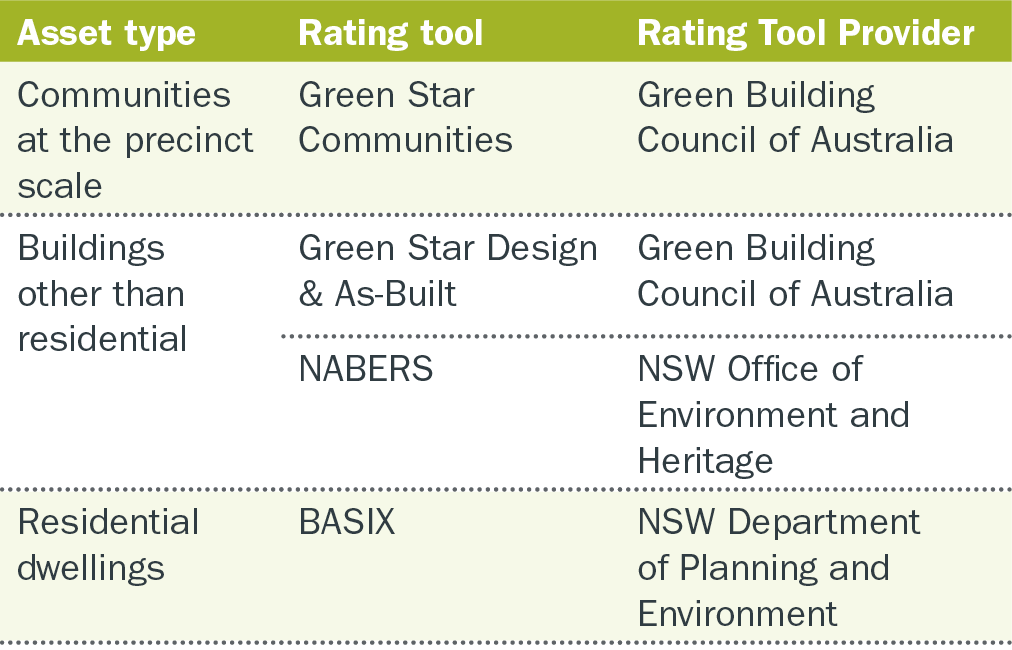
In some instances, Landcom may also agree to use other rating tools in lieu of, or in addition to, those outlined. This is at the discretion of Landcom.
For our FY18 activities related to Environmental Management, see Environmental Management Performance Results below.
-
Climate & Resilience
Landcom’s approach to Climate & Resilience includes understanding our risks to climate change and its impacts, ensuring our communities are adaptable to change, addressing known climate risks – such as urban heat island6 – immediately, and maintaining our commitment to enhancing local biodiversity and ecology.
Extensive work on resilience has been led across Sydney since our city’s inclusion in the international 100 Resilient Cities program (100RC). Funded by the Rockefeller Foundation, 100RC is working with 31 cities internationally to enhance their resilience to shocks and stresses. Landcom has collaborated with, and taken guidance from, the work of the Resilient Sydney team. In FY18, we adopted a framework used to assess our projects for exposure to climate change risks. This has been accompanied by the development of a Resilience-In-Design checklist to support project teams and their consultancies. The checklist guides the teams to consider common climate risks during the early phases of a project’s design. The assessment framework also feeds into community adaptation plans that are designed to enhance the resilience of our communities in the way they live day to day.
In FY18 we also commenced our Healthy & Inclusive Places Survey, and sought direct feedback from residents of Landcom communities, on their preparedness for an emergency. These insights will support any climate adaptation and community resilience work Landcom may choose to integrate into our Community Development programs (see Health, Equity & Inclusion).
Landcom is also taking steps to address known risks immediately, which includes reducing the effects of urban heat island across our new communities. As one of Sydney’s most significant climate related risks, early design interventions to address urban heat is required in the creation of new communities. To improve industry’s ability to understand and measure urban heat, Landcom is also an ongoing partner of the Cooperative Research Centre for Low Carbon Living (CRCLCL) – and actively engaged in the development of an urban heat island mitigation decision support tool.7
Finally, Landcom also seeks to address resilience in the natural environment. This is achieved when we maintain strong diversity of our ecological systems. We address this through the use of our Biodiversity Calculator, to measure the quality and quantity of ecological communities beyond any legislative requirements, pre- and post-development — aiming for a net positive outcome at the completion of our projects.
For our FY18 performance against our Climate & Resilience targets, see Climate & Resilience Performance Results below.
6 Urban Heat Island Effect (2018) http://www.cityofsydney.nsw.gov.au/vision/towards-2030/sustainability/carbon-reduction/urban-heat-island
7 Urban Heat Island Mitigation Decision Support Tool (2018) http://www.lowcarbonlivingcrc.com.au/research/program-2-low-carbon-precincts/rp2023-microclimate-and-urban-heat-island-mitigation
-
Waste & Materials
Landcom’s environmental leadership goal for 2028 includes enabling zero waste communities. To do this, we are advocating for responsible use of resources, and diversion from landfill. Landcom has long held a waste diversion from landfill target, which has been maintained in our new Sustainable Places Strategy.
While we are focused on reducing waste within our own offices, it is construction waste that is material to Landcom’s operations. As part of our ISO14001 Environmental Management System, Landcom continues to engage with our site superintendents and principal contractors to reduce, reuse or divert waste from landfill. This includes ongoing training and reporting with these key stakeholders.
To advance our commitments further, we have also included the responsible sourcing of timber for all construction works. This target also increases engagement with our supply chain, and supports our work underway within our Accountable & Collaborative Places pillar.
For our FY18 performance results against our Waste & Materials targets, see Waste & Materials Performance Results below.
Performance Results
See below our performance results for each of the reporting areas within our Climate Resilient Places Pillar.
Climate & Resilience Performance Results
Landcom’s Sustainable Places Strategy addresses Climate & Resilience. This focus area forms part of our Climate Resilient Places pillar and is a representation of our commitment to delivering resilient communities that balance ecological outcomes, reduce climate related stresses and build community resilience.
![]()
FY18 Targets and Performance
| Indicator | Objective | Target | FY18 Performance |
|---|---|---|---|
| Climate & Resilience |
To respect, conserve and regenerate our natural environment and embed adaptation and resilience into all precincts, and expand community awareness. |
All new projects to undertake a Climate Resilience Assessment |
5 out of 9 complete |
|
All new projects prepare and implement an effective Climate Adaptation and Community Resilience Plan |
2 out of 9 complete |
||
|
All new projects enhance the local habitat, biodiversity or ecological communities, compared to the site conditions pre-acquisition or pre-masterplan (Landcom Biodiversity Calculator) |
67% make a positive contribution |
||
|
Total project site area in plan view comprised of building or landscape elements that reduce the impact of urban heat island effect Greenfield Projects: 50% project site area Renewal or High Density Projects: 20-50% project site area (calculation in accordance with Green Star Communities) |
100% of projects in scope achieved |
-
Climate Change Risk and Community Resilience
In FY18, Landcom collaborated with consulting firm AECOM to enhance our current project portfolio’s resilience to climate related risks, and increase our internal capacity to ensure all future projects are resilient. Key actions to enable this included:
- Completing a climate change risk review of Landcom’s current portfolio against the Intergovernmental Panel on Climate Chance Fifth Assessment Report (IPCC AR5) climate projections for 2030 and 20908
- Based on the above review, identifying and prioritising projects exposed to high risks, for detailed climate change resilience assessments
- Developing a climate resilience pro forma to assess all future Landcom projects consistently, and testing of the pro forma at the two projects identified in action 2 above
- Creating a Resilience-in-Design checklist for guiding projects in concept development.
A total of five of the nine new projects and all the legacy Landcom projects were reviewed against the IPCC AR5 climate projections, including Lachlan’s Line, Epping, Cherrybrook, Showground, Tallawong, Edmondson Park, Bonnyrigg, Claymore, Airds and Macarthur Heights and Macarthur Gardens North.9 Across these projects, we saw a trend of exposure to risks of extreme heat, bushfire, extreme rainfall events and flooding.
Extreme heat was rated as an ‘extreme risk’ at four Landcom communities, which is consistent with the top risks to Sydney identified by Resilient Sydney.10 This finding further confirms the importance of Landcom’s priority to reduce or mitigate the effects of urban heat island, and build community resilience to heat at all new projects.
Tallawong and Edmondson Park were the two projects prioritised to pilot the climate resilience assessment pro forma developed to support Landcom projects. Detailed resilience assessments and community adaptation plans were also developed for both projects during the reporting period.
In FY19, we will complete the assessment of the four remaining new projects and finalise detailed resilience and community adaptation plans for the remainder of the project portfolio. As the majority of these projects still have planning and design to undertake, we have a great opportunity to materially reduce the climate risk profile of these future communities through the masterplanning process.
We also developed a Resilience-in-Design Check List, to support projects at the concept development phase. This Check List can be used by teams when briefing their design and engineering consortiums to ensure climate risk mitigation and resilience is embedded into Landcom communities from project inception.
8 What is the IPPCC AR5 Assessment Report? https://www.ipcc.ch/report/ar5/
9 Not all projects that participated in the risk review are in scope for FY18 reporting against our climate resilience targets as we sought a spectrum of project types to test the assessment process.
10 City of Sydney Resilient Sydney (2018) http://www.cityofsydney.nsw.gov.au/vision/towards-2030/resilient-sydney.
-
Urban Heat Island Reduction
Heat continues to be a major stress for many cities across Australia, as confirmed by our climate change risk assessments. Landcom’s commitment to reduce urban heat island effect (UHI) will contribute to reduced risk of extreme heat at our projects. This will enhance the resilience of our communities, and the residents that live there.
As part of our Sustainable Places Strategy, we have committed to reducing the effects of UHI through the provision of landscape and design elements that mitigate heat retention. This includes requiring appropriate provision of green open spaces within our communities, increasing canopy cover and using materials that reflect (rather than absorb) heat, such as light coloured roofs.
It is important to note Landcom has adopted two separate targets for UHI, related to different development typologies. Our greenfield projects with low density and detached dwellings are required to achieve a much higher UHI mitigation target (50%) compared to high density or infill projects (20%). This distinction has been designed to address the challenges infill or high density projects often experience when responding to existing urban environments, or constrained sites.
In FY18 we undertook a detailed assessment of existing Landcom communities to better understand how our current and past design practices influence UHI effects. It is important to note that all projects reviewed were largely complete or well underway for delivery before Landcom adopted its UHI targets, and therefore most are not in scope for performance reporting in FY18.
Greenfield projects reviewed included Edmondson Park, Oran Park Town, Macarthur Heights, Renwick, Bonnyrigg, Claymore and Airds; while our infill or high density communities were Green Square, Tallawong, Showground and Lachlan’s Line.11 Half of these projects met or exceeded our new UHI targets, despite not having been designed to address UHI. This is largely due to the integration of parks, open spaces and riparian or other protected bushland into the design of our communities.
Our most insightful project reviewed was Oran Park Town, which commenced construction in early 2007. A key priority of landscape design at that time was the use of endemic tree species, especially for street trees. Unfortunately the profile and leaf structure of Australia’s native trees can cast limited shade, and make a low contribution to urban canopy cover — despite their many other benefits. Consequently, while Oran Park has a high proportion of street trees, they make little contribution to reducing UHI effects.
Insights like this will support Landcom to approach the future design and delivery of our communities in a way that nurtures our native ecological communities, while addressing the need to reduce UHI effects and building resilience to the stress of extreme heat experienced across NSW.
11 Of the projects analysed, Tallawong, Showground and Edmondson Park are considered in scope for reporting in FY18. All met or exceeded our UHI target.
-
Biodiversity
FY18 is the first year Landcom will report the contribution we make to biodiversity and ecological systems. To support the business in measuring this, we developed our Biodiversity Calculator, based on the Green Building Council of Australia’s change in ecological value calculator provided in Green Star tools.
Landcom’s Biodiversity Calculator is designed to measure the change in quality and quantity of biodiversity at a given project site, from pre-development to post development. The calculator goes beyond just assessing high-value and significant biodiversity (which legislation requires to be conserved) and factors a broader spectrum of biodiversity value into the assessment. Depending on the level of quality and quantity change, the calculator determines whether a net positive or net negative impact has been achieved. It is possible to have a net positive outcome in biodiversity, despite a reduction in physical area – if the quality of that area has been significantly improved.
The scale provided by the calculator is as follows.
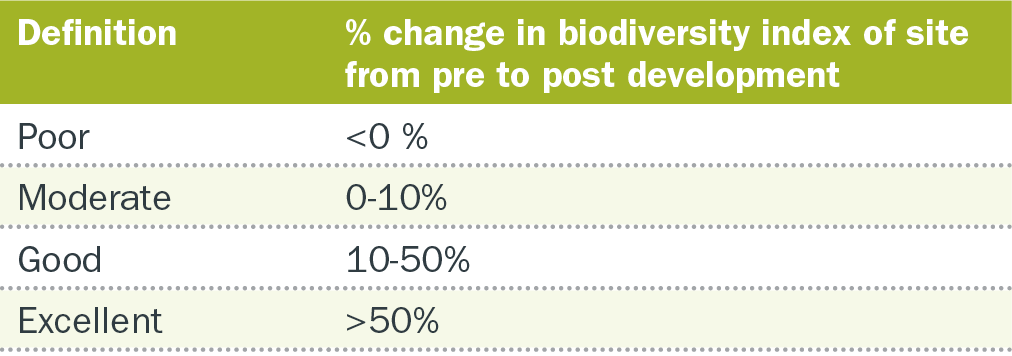
We acknowledge that land development and retention of biodiversity are sometimes at odds. Despite our best efforts to retain existing flora and fauna at all our sites, sometimes this is not possible. However, we do aim to always have a net positive outcome at our projects. Some methods we may use include biodiversity offsets12, and restoration works – such as improving eroded riparian corridors to full health.
For projects in scope for FY18 reporting (Tallawong, Kellyville, Showground, Epping, Macarthur Gardens North and Edmondson Park), 67% are currently making a net positive biodiversity contribution. Once complete, Edmondson Park and Macarthur Gardens North will both reduce the overall area of onsite biodiversity from pre-development to post-development, but still return net positive outcomes due to the enhancement in biodiversity quality. At each project, significant remnant habitat will be enhanced from poor to good condition — and native habitat offsets will be employed to manage the reduction in habitat area.
The remaining sites assessed form part of the Sydney Metro NorthWest (SMNW) Places program. Each of these sites is co-located at a new metro station, being delivered by Transport for NSW (TfNSW). TfNSW is also the land owner of these projects, and Landcom has been appointed as the master developer for the surrounding communities.
Of the SMNW Places assessed, Showground and Epping are forecast to contribute a moderate (net positive) change in biodiversity value based on the calculator scale above, whereas Tallawong and Kellyville are forecast to have a ‘poor’ (net negative) change in biodiversity. As Landcom is not the land owner of the SMNW corridor and its associated project sites, management of biodiversity offsets and other approvals is beyond our operational control. Landcom will continue to review opportunities to elevate the performance of sites such as Tallawong and Kellyville through project divestment and delivery strategies.
In FY19, we will leverage the insights gained from our Healthy & Inclusive Places Survey, which showed that 20% of resident satisfaction with the design of their community was related to its connection with the natural environment. This clearly reveals that residents value the contribution local biodiversity and ecology makes to their lives, and supports Landcom in advancing our commitment to achieve net positive biodiversity outcomes across all new projects.
12 Through schemes such as the NSW Office of Environment and Heritage Biodiversity Offset Scheme and BioBanking Trust.
Energy & Emissions Performance Results
Landcom’s Sustainable Places Strategy addresses Energy & Emissions. This focus area forms part of our Climate Resilient Places pillar and is a representation of our commitment to delivering energy efficient communities that reduce greenhouse gas emissions, advance uptake in renewable energy technologies, and reduce the cost of living to residents.
![]()
FY18 Targets and Performance
| Indicator | Objective | Target | FY18 Performance |
|---|---|---|---|
| Energy & Emissions |
To conserve energy and drive energy efficient, low carbon, low emissions precincts for the future. |
All new projects modeled to reduce Green House Gas (GHG) emissions at a precinct scale (transport & stationary) by 50% against 2016 reference case (CCAP PRECINX) |
46% reduction |
|
5% of predicted precinct energy demand supplied from onsite renewable energy, where site constraints permit |
No new projects in scope 14 |
14 These targets apply to the delivery of new project in FY18; we did not deliver any new projects in FY18 for which this target is relevant.
-
Greenhouse Gas Emissions Reduction
Our emissions reduction target seeks to minimise stationary and transport emissions through the adoption of energy efficient design, renewable energy infrastructure, transport mode split and parking strategies, and incentives to encourage efficient appliances. The emissions reported are the predicted operational emissions of a masterplan at completion and are calculated using the sustainability modelling tool PRECINX.
FY18 is the first time Landcom has adopted a greenhouse gas (GHG) emissions reduction target for projects. New projects, or individual precincts within ongoing projects, that are currently in the planning and design stages are in scope for FY18 reporting15 and accounts for over half of Landcom’s overall predicted emissions (see Figure 3). New projects reported include Tallawong, Showground, Edmondson Park and Lachlan’s Line.The weighted average GHG emission reductions expected across the new projects in scope for FY18 is 46%16 (see Figure 4). Medium density projects have achieved the highest reductions; for example, the concept schemes at Edmondson Park achieved a 59% reduction with the proposed strategies.
New higher density projects present Landcom with the greatest challenge to meet our targets, due to the reduced site area and roof-space available to incorporate renewable energy technologies in a cost-effective way. Moving forward, Landcom will be focussing on opportunities to increase energy efficiency and reduce the GHG emissions at higher density projects.
For completeness, we are also reporting the achievements of legacy projects underway before the adoption of the Sustainable Places Strategy (see Figure 4). Of the projects included in our baseline legacy results, the stages at Macarthur Heights currently in delivery are forecast to have the greatest emissions reductions, at 56%. This project is nearing completion, with the majority of civil and community infrastructure delivered, and civil works for the last stage of lot subdivisions remaining to be completed and released for sale in the coming year.
In FY18, residential dwellings are our most material emissions source (see Figure 5). Emissions from dwellings were forecast to achieve a 52% reduction across new projects, while transport emissions are the second most material with a predicted reduction of 47%.
Non-residential land uses are expected to achieve an 8% reduction, however this only accounted for 15% of overall emissions across our new project portfolio. In FY19 we will continue to focus on opportunities to further reduce residential and transport emissions.
While our emissions target is designed to address new projects, in FY18 we also workshopped opportunities to make a meaningful impact at projects that have already moved through the planning and design phase. In consultation with the project teams and marketing teams, we concluded that a rebate incentive for residents currently going through a new home build presented the greatest marketable opportunity to lower emissions in established communities at this point in the market cycle (see our Sustainability Rebate Case Study).
15 Performance is based on projected performance for all new Landcom projects, until such time as the delivery or divestment strategy for each project is confirmed. At this time, results will become ‘actuals’
16 Reduction from the reference case. Landcom chooses to use its PRECINX tool for modelling potable water and Greenhouse Gas emission reductions. 2016 reference case is defined as the normalised relevant metropolitan average applied to a masterplan.
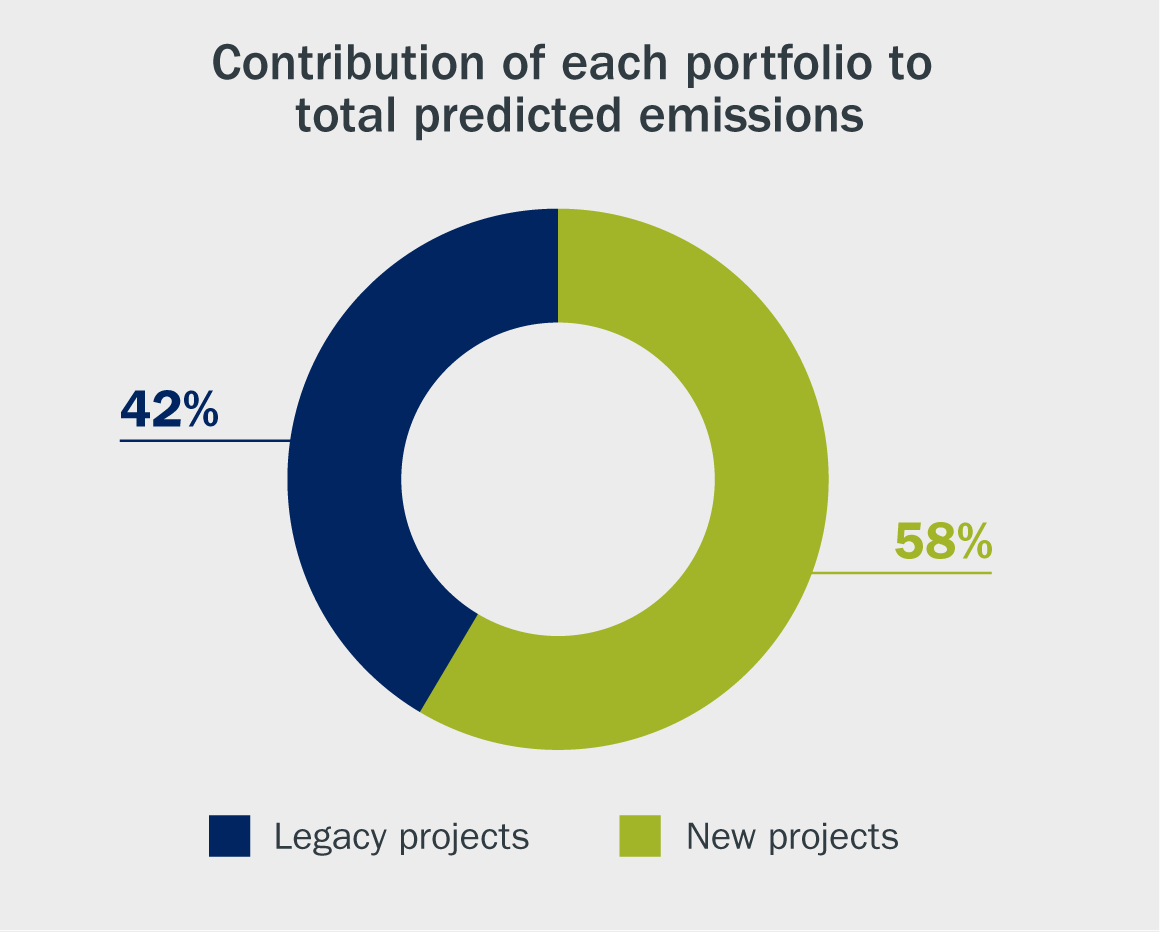
Figure 3 Contribution of each project portfolio to our total predicted emissions, showing that the quantum of emissions from our new project portfolio is more material than our legacy projects, due to the proportional size of each portfolio.
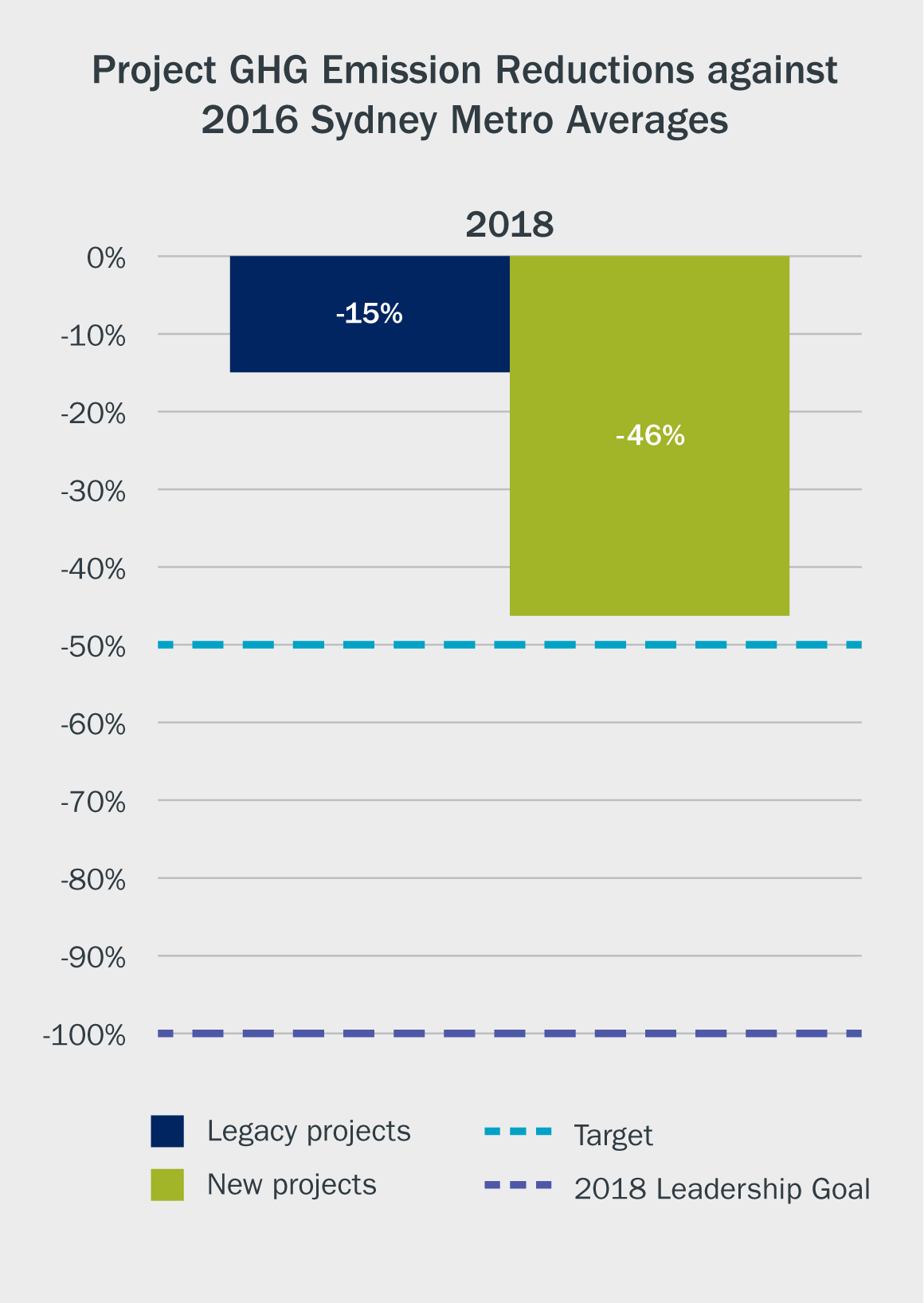
Figure 4 Predicted GHG emissions reductions from Landcom project portfolio, against FY16 baseline, modelled using PRECINX. Results show our ‘New’ projects which are in scope for reporting during FY18, and for completeness our ‘Legacy’ projects, which are out of scope for the targets.
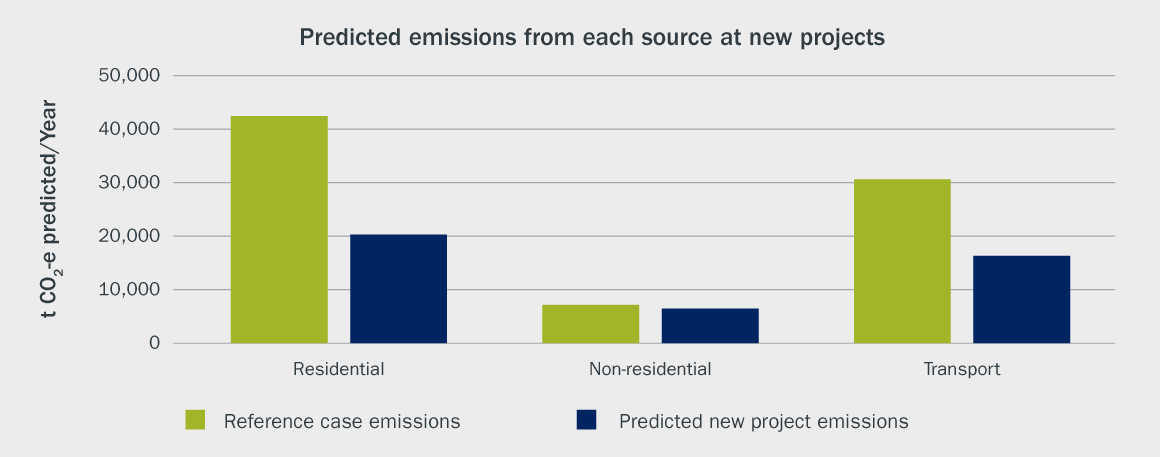
Figure 5 Predicted emission from each source compared to the reference case for each source in our New Project portfolio
-
Onsite Renewable Energy
In FY18, Landcom had no projects in scope for reporting the inclusion of onsite renewable energy. This is due to no new projects having been acquired for delivery by Landcom, or sold with agreed contracts of sale to the private sector during the reporting year.
Landcom’s onsite renewable energy target is for 5% of total site demand at the precinct scale to be delivered by onsite renewable energy. This extends beyond the inclusion of solar panels on residential homes, and requires a strategic precinct scale response. The intent of this target is to drive innovation and large scale integration of renewable energy sources at the project site.
Environmental Management Performance Results
Landcom’s Sustainable Places Strategy addresses Environmental Management. This focus area forms part of our Climate Resilient Places pillar and is a representation of our commitment to delivering communities that achieve or exceed independent third party rating systems or standards.
![]()
FY18 Targets and Performance
| Indicator | Objective | Target | FY18 Performance |
|---|---|---|---|
| Environmental Management |
To maintain and enhance a culture of high environmental performance. |
All projects will adopt the use industry recognised rating tools at a masterplan and built form scale, achieving not less than ‘Australian Best Practice’ equivalent (Green Star preferred) |
No new projects in scope 17 |
|
NABERS: Office, Hotel & Retail – Commitment Agreement or designed-to 5 Star Energy and Water |
No new projects in scope 17 |
||
|
BASIX energy: Detached & Semi - 60; Low-Rise - 55; Mid-Rise - 45; High-Rise - 40 BASIX water: all dwellings - 60 |
No new projects in scope 17 |
17 These targets apply to the delivery of new project in FY18; we did not deliver any new projects in FY18 for which this target is relevant.
-
FY18 Targets and Performance
Our FY18 performance results are presented above. None of our Environmental Management targets were in scope for reporting this year, as no new projects were commenced or delivered to market during the reporting period that would enable these targets to be adopted.
-
Green Star Certification
Green Star, administered by the Green Building Council of Australia, is Landcom’s preferred independent and voluntary rating tool for precincts and built form. Landcom is committed to achieving ‘Australian Best Practice’ project certifications for all new projects. This equates to what is commonly known as a ‘5 Star Green Star’ rating.
Landcom’s preferred industry rating tool for our assets is Green Star - Communities, which predominantly assesses all elements of a project beyond the individual lot boundary. This aligns strongly with Landcom’s project delivery model, as we generally18 deliver or enable all subdivision, major infrastructure and landscaping works, leaving the design and construction of the built form to the lot owner.
In some instances Landcom may seek to use, or require the use of, the Green Star Design & As-Built rating tool. This tool assesses the sustainability of built form such as community centres and other community based infrastructure, and commercial buildings.
Green Star is a comprehensive rating system that addresses the sustainability of a project from site acquisition through to construction completion. Landcom’s target seeks to incorporate the application of a project rating into the initial due diligence and concept design for a project, to realise the most cost efficient and holistic outcomes.
In FY18, Landcom had no new projects in scope for this target. Throughout the reporting period we did review our existing asset portfolio for any projects that may be suitable to certify a rating, despite having finished due diligence and concept design stages. We will continue to pursue opportunities at our existing projects in 2019.
We also continued to support the City of Sydney to obtain a rating at Green Square Town Centre. Both Landcom and Mirvac are Project Delivery Agreement (PDA) partners for this project, and the City of Sydney is the Applicant for this rating (see our Case Study: Green Square Town Centre, Green Star Communities Collaboration).
18 With the exception of a small number of public facilities and home construction projects we deliver on behalf of other government agencies, such as the NSW Land and Housing Corporation.
-
NABERS Certification
Landcom adopts the National Australian Built Environment Rating System (NABERS)19 as its preferred independent and voluntary rating system to validate the operational sustainability of eligible non-residential built form. NABERS measures a building’s operational energy efficiency, carbon emissions, water consumption and waste production on an annual basis, and awards a star rating out of six.
Landcom is committed to requiring a NABERS rating at new projects that include office, retail or hotel built form. A NABERS rating can only be ensured at Landcom projects through collaboration with future building owners and operators, and will be achieved through conditional requirements within contracts of sale to future site owners.
As Landcom had no new projects released to market and sold within the reporting period, this target is not in scope for FY18.
Aligning with the NSW Government Resource Efficiency Policy (see NSW Government Resource Efficiency Policy (GREP)), Landcom maintains a NABERS rating for our head office tenancy in Parramatta. In FY18, we achieved a 6 Star NABERS Energy Rating, representing a ‘Market Leading’ performance.
19 What is NABERS? (2018) https://www.nabers.gov.au/about/what-nabers
-
BASIX Certification
We measure the energy and water efficiency of homes built by Landcom in accordance with the Environment and Planning Assessment Act Building Sustainability Index (BASIX).20 BASIX is administered by the Department of Planning and Environment (DPE), applies to residential developments, and aims to deliver equitable, effective water and greenhouse gas emission reductions across NSW.
‘BASIX targets are calculated as a percentage savings against the NSW average benchmarks (being the average per-person water consumption and greenhouse gas emissions levels across the state). These percentage savings are then expressed as a target, i.e. BASIX 50 represents a 50% saving against the benchmark. BASIX assesses a proposed dwelling based on these benchmarks, and taking into account regional variations such as soil type, climate, rainfall and evaporation rates.’21
Landcom has included BASIX targets in its sustainability commitments since 2005. When adopting our new Sustainable Places Strategy in FY18, we updated our BASIX targets to reflect our new aspiration for leadership in sustainability. As at 1 July 2017, DPE also increased the regulatory minimum BASIX energy requirements, in response to a review of the rating system.
BASIX Certificates are generated in accordance with the design of a new residential development, based on the specifications of that building. A BASIX Certificate must accompany any development application or complying development application, before approval for that building is provided. Once construction is complete, a BASIX completion receipt is issued if an independent certifier confirms the home has been built in accordance with the BASIX specifications. Landcom uses the BASIX completion receipt to validate the percentage of homes within our portfolio designed and delivered in accordance with our targets.
As Landcom only adopted our new BASIX target in November 2017, all homes we constructed in FY18 were designed to comply with our former BASIX targets, and as such are out of scope for this reporting period. However, for completeness we have continued to collect and report the performance of these dwellings.
In FY18, a total of 23 single-dwelling and 14 multi-dwellings were completed by Landcom, yielding a combined weighted average22 BASIX energy score of 47, and water score of 41. Of those, single dwelling homes performed better in energy (energy score of 51), compared to multi-dwellings (energy score of 41). Across the board, the BASIX water scores for all dwelling types were consistent (between 40 and 42) as none of the sites had access to reticulated recycled water. These performance results are below our former Landcom BASIX targets, which is a direct result of projects that used Integrated Development Assessment (IDA) approval pathways.23
Where an IDA is sought, the masterplan and all dwellings are approved under the one development application. As part of the IDA process, consolidated BASIX certificates were issued per project (or project stage), which averages the BASIX performance across all dwellings and typologies. Multi-dwelling BASIX requirements are lower than those for single-dwellings.

Therefore, the combined average BASIX certificate is not reflective of the different standards between typologies. Thus, results can be positively or negatively weighted, depending on the make-up of that community.
Of the 14 multi-dwellings presented in our results this year, the majority are subject to IDA BASIX certificates. If we exclude those homes, Landcom’s weighted portfolio BASIX energy score rises to an energy score of 56, and water score of 42. This is in line with our recent performance trend, and is reflected in our BASIX historical trend graphs presented below.
During FY18, we also went to market with Expressions of Interest (EOIs) for approximately 1,550 dwellings across our Tallawong and Showground projects, as part of the Sydney Metro NorthWest (SMNW) Places program. Within these EOI, Landcom articulated our commitment to deliver against our Sustainable Places Strategy BASIX targets.
These two sites are expected to settle in FY19 and we will look forward to reporting the outcomes.

Figure 6 Historic trend for BASIX Water, including Legacy projects

Figure 7 Historic trend for BASIX Energy scores of legacy projects.
20 What is BASIX? https://www.planningportal.nsw.gov.au/planning-tools/basix
22 Weighted by occupancy.
23 Integrated Development Assessments (IDA) enabled the approval of a project Masterplan and all dwellings, under one application. This can streamline the development process. IDAs were progressed for a number of projects where Landcom is working on behalf of NSW Land and Housing Corporation.
Waste & Materials Performance Results
Landcom’s Sustainable Places Strategy addresses Waste & Materials. This focus area forms part of our Climate Resilient Places pillar, and is a representation of our commitment to delivering communities that reduce waste, and source materials responsibly.
These focus areas contribute to our leadership goal to enable zero waste communities by 2028.
![]()
FY18 Targets and Performance
| Indicator | Objective | Target | FY18 Performance |
|---|---|---|---|
| Waste & Materials |
To drive innovation in waste reduction, and further enable the use of responsible resources. |
All new projects divert minimum 95% construction waste from landfill (excluding contamination or hazardous materials) |
No new projects in scope 25 |
|
100% timber sourced for construction (by cost) is Forest Stewardship Council Certified or agreed equivalent (ie Australian Forestry Standards) |
No new projects in scope 25 |
25 These targets apply to the delivery of new project in FY18; we did not deliver any new projects in FY18 for which this target is relevant.
-
Waste
Landcom continues to place a high value on transparently reporting our impact on local environments. We are advancing our approach to focus on how we can achieve net positive environmental outcomes, including zero waste communities.
We have included a waste diversion from landfill target in our sustainability approach for many years. When adopting our Sustainable Places Strategy targets, we chose to carry forward our existing target to divert 95% of construction waste from landfill. However, we have made some adjustments to the way we calculate our waste target, primarily in the exclusion of hazardous waste and contamination volumes from the figures to align more closely with the standards set out in the Green Star rating tools.
In FY18, Landcom had no new projects within scope for reporting against our waste diversion target. Legacy Landcom projects that generated waste in FY18 reported a 92% diversion from landfill. The majority of waste was generated at Bonnyrigg, Oran Park Town and Renwick, with asphalt and concrete, vegetation and fill (soil) being the most significant recycled materials.
As these projects are operating under contracts that pre-date the adoption of our Sustainable Places Strategy, they are technically out of scope, however we are disclosing their waste diversion attainment in FY18 for completeness.
Consistent and accurate waste reporting remains a challenge across the development industry. In FY19 we will continue to work on process improvements for collecting waste data, with a focus on how to increase supporting evidence from contractors. With greater data accuracy, Landcom can improve our focus on material waste streams, increase our reporting accuracy, advance performance against our 95% diversion target and ultimately achieve zero waste communities.
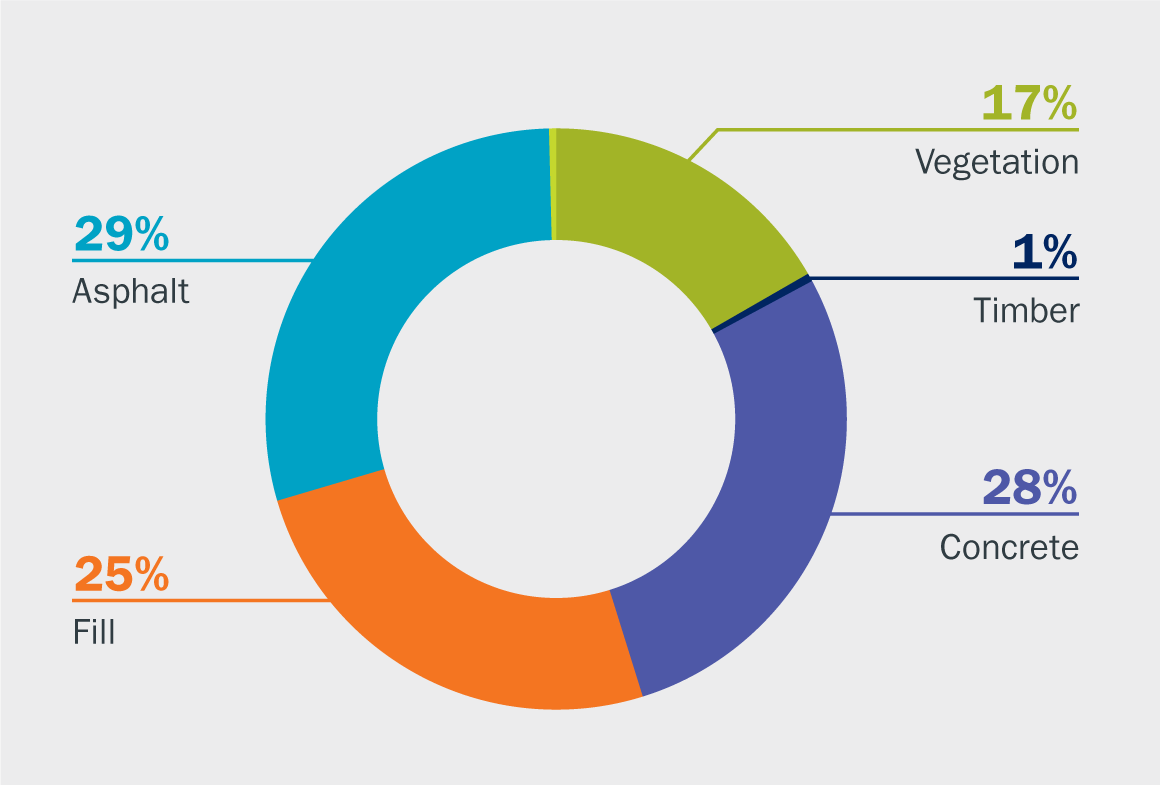
Figure 9 Breakdown of waste streams diverted from landfill
-
Materials
In FY18, Landcom began including the use of 100% Chain-of-Custody Certified timber as a key opportunity within our EOIs for new projects. As none of these projects sold within the reporting year, there are no projects in scope for this target during FY18.
Landcom will report our performance against this target in FY19.
Water Performance Results
Landcom’s Sustainable Places Strategy addresses Water. This focus area forms part of our Climate Resilient Places pillar, and is a representation of our commitment to delivering communities designed for best practice water sensitive urban design which actively conserve potable water.
These focus areas contribute to our leadership goal to enable water positive communities by 2028.
![]()
FY18 Targets and Performance
| Indicator | Objective | Target | FY18 Performance |
|---|---|---|---|
| Water |
To design our precincts based on best practice Water Sensitive Urban Design principles, and actively conserve potable water. |
Water Sensitive Urban Design strategy for all projects, pollutant discharge loads not to exceed Nitrogen 45, Phosphorus 65, Suspended Solids 85, Gross Pollutants 90 |
No new projects in scope 26 |
|
All new projects modelled to reduce mains potable water demand by 50% at the precinct scale, against a 2016 reference case (PRECINX) |
49% reduction |
26 These targets apply to the delivery of new projects in FY18; we did not deliver any new projects in FY18 for which this target is relevant.
-
Water Sensitive Urban Design
Landcom views Water Sensitive Urban Design (WSUD) as integral to the sustainable water cycle management of our projects. WSUD can include the rehabilitation and protection of natural waterways, design elements such as wetlands, rain gardens, water harvesting and storage and efficient fittings, and alternative water sources such as recycled or blackwater.
The intent of our target is to ensure our projects are designed with these opportunities in mind, and to ensure any stormwater runoff from our sites does not exceed our prescribed pollutant loads and impact the sites downstream from our communities.
In FY18 we had no projects in scope for reporting against our WSUD target. According to the MUSIC modelling assessment tool, legacy Landcom projects with WSUD initiatives delivered during FY18 achieved 69% average annual Nitrogen pollution load reduction, compared to developments without WSUD controls. The results of the modelling show that these legacy developments met, and exceeded, Landcom’s WSUD target of 45% nitrogen reduction.27
The Legacy projects reported in FY18 were Oran Park and Renwick, and the assessment highlighted that both had very high total nitrogen reductions of 62.9% and 71.8% respectively, far exceeding the target of 45%. This achievement is significantly higher than previous years, where a broader spectrum of site typologies (for example with more hardscape or less landscaping, with or without stormwater treatment trains etc.) pulled our weighted portfolio performance down.
As part of the EOIs for the sale of both Tallawong and Showground, a commitment to achieve the Landcom WSUD targets was requested from proponents. We will look forward to reporting the final performance commitments made by the successful proponents of these sites in the FY19 report.
27 Landcom’s former approach to WSUD only measured nitrogen reduction, as is reported for legacy projects above. Our new Sustainable Places Strategy has been updated to include phosphorus, suspended solids and gross pollutants, in line with best practice.
-
Potable Water Reduction
Our potable water reduction target seeks to reduce the use of unnecessary potable water and improve the efficiency of potable water that is used. The potable water consumption reported is the predicted operational consumption of a masterplan at completion, and is calculated using the sustainability modelling tool PRECINX.
FY18 is the first time our organisation has adopted a potable water reduction target for projects. New projects, and individual precincts within ongoing projects, that are currently in the planning and design stages are in scope for FY18 reporting28, and accounts for 68% of Landcom’s predicted overall consumption (see Figure 10). This includes Tallawong, Showground, Edmondson Park and Lachlan’s Line.
Our weighted average potable water consumption reduction projected across new projects in scope for FY18 is 49%29 (see Figure 11). The typical strategies used to achieve the targets is to maximize the water harvesting, and support this with higher efficiency appliances and fittings.
In FY18, residential dwelling were forecast to achieve 50% potable water reduction, and non-residential water reductions are 14% across our new projects. Despite this, non-residential land uses for new projects account for only 6% of overall potable water use.
New projects without access to recycled water present Landcom with the greatest challenge to meet our targets. Without access to recycled water infrastructure, potable water reductions greater than 50% at the precinct scale become technically challenging, and infrastructure such as private grey and blackwater treatment systems can ultimately have a negative impact on cost of living for our residents. Despite the challenges this presents, there is also opportunities for innovative design, partnership and technology solutions.
For completeness in establishing our baseline data for this target, we have also presented the potable water reductions achieved by our legacy projects that are still in delivery (see Figure 11). These projects include Bonnyrigg, Claymore, Airds, Macarthur Heights, Renwick, Oran Park and Green Square Town Centre. When calculating our performance inclusive of new and legacy projects, Landcom’s weighted portfolio is expected or projected to achieve a 46% average potable water reduction.
In FY19, Landcom plans to collaborate more closely with Sydney Water, and other utilities and authorities, to better understand water cycle opportunities for our project portfolio and pursue the solutions which work under existing governance structures. This also supports our aim to improve the cost of living for residents in Landcom communities.
28 Performance is based on projected performance for all new Landcom projects, until such time as the delivery or divestment strategy for each project is confirmed. At this time, results will become ‘actuals’.
29 Reduction from the reference case. Landcom chooses to use its PRECINX tool for modelling potable water and Greenhouse Gas emission reductions. The reference case is defined as the normalised relevant 2016 metropolitan average applied to a masterplan.
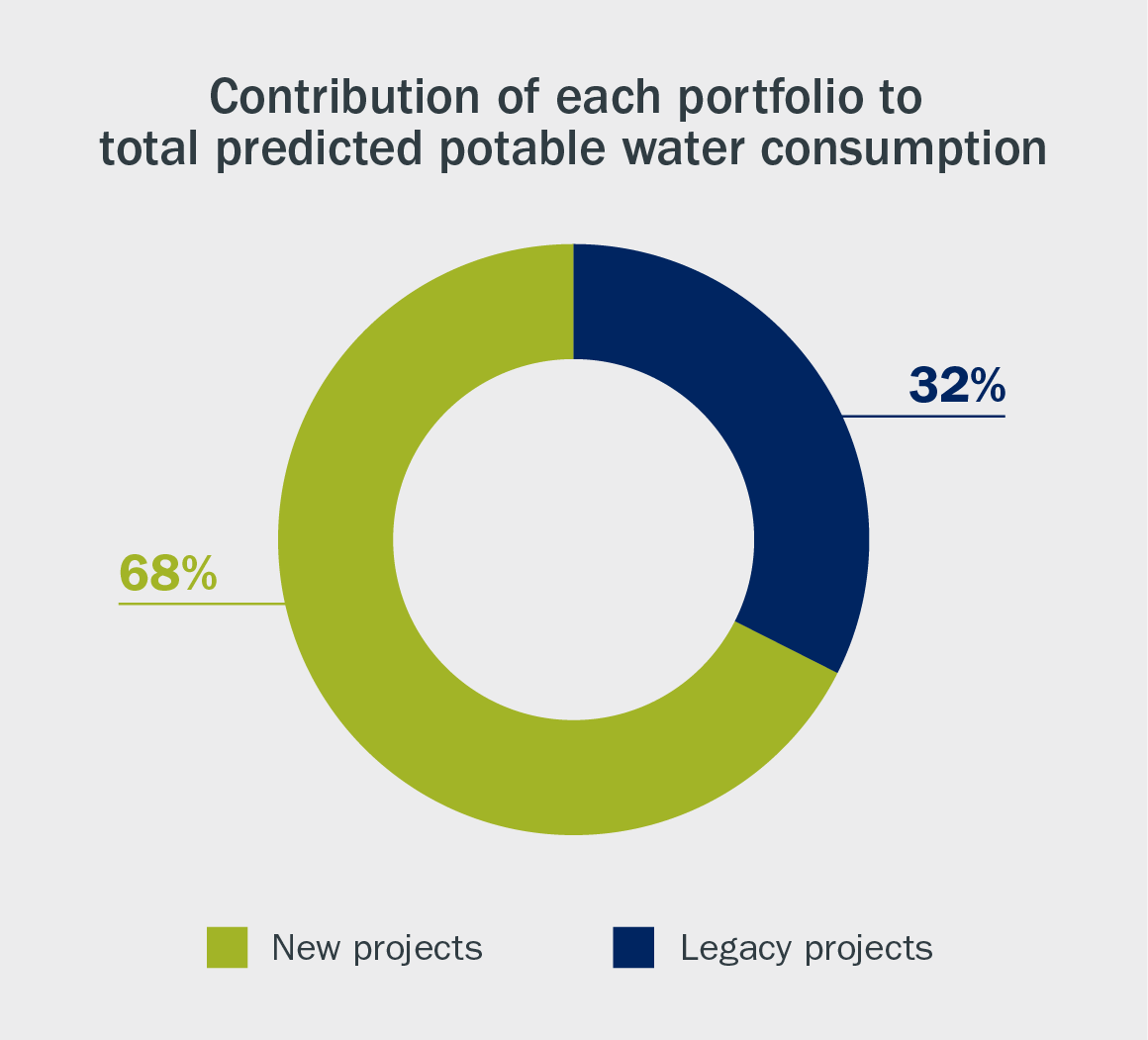
Figure 10 Contribution of each project portfolio to our total predicted potable water consumption, showing that the quantum of consumption from our new project portfolio is more material than our Legacy projects due to the size of each portfolio.
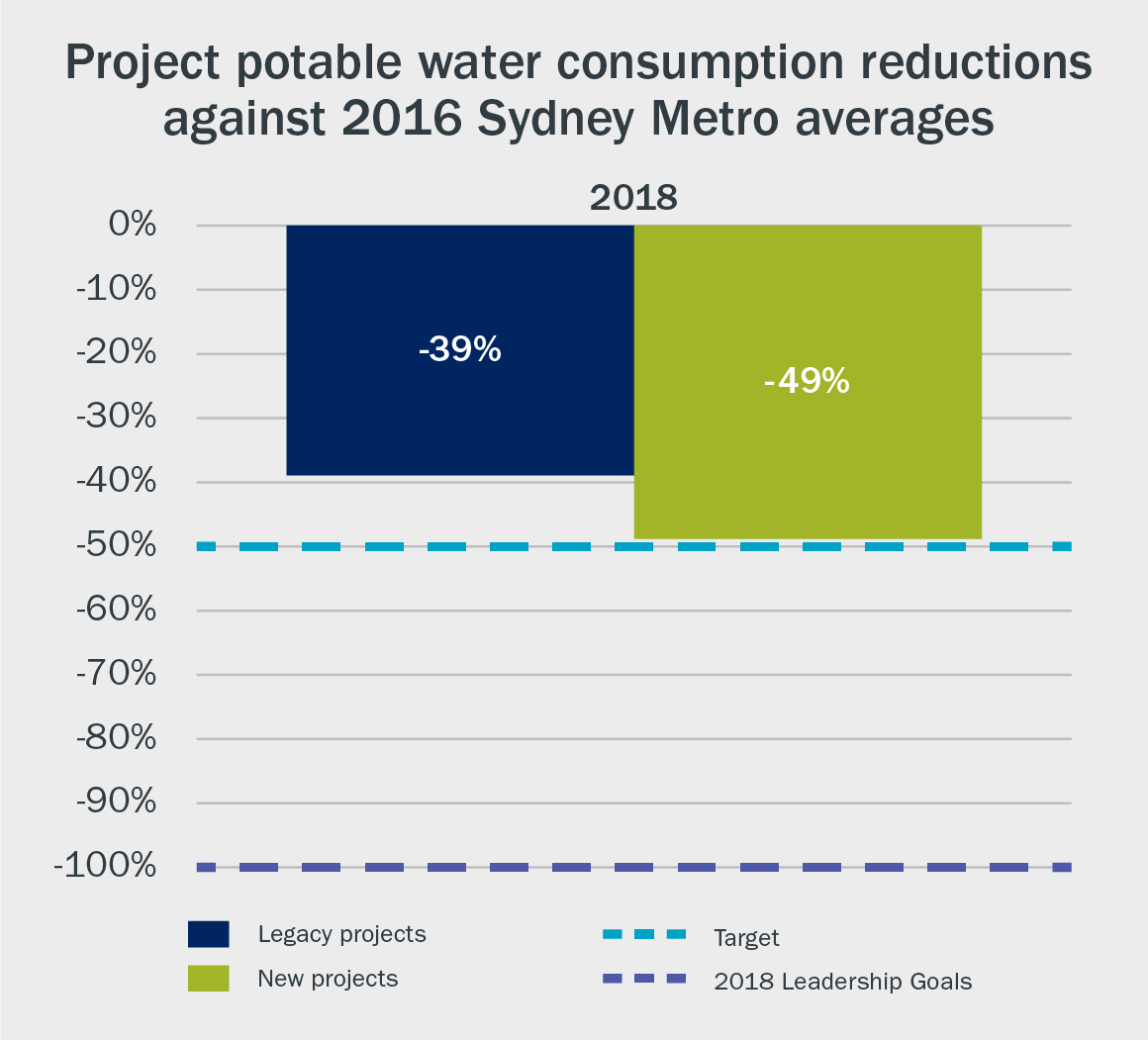
Figure 11 Potable water consumption reduction of Landcom’s project portfolio, modelled using PRECINX. Results show our ‘New’ projects which are in scope for reporting during FY18, and for completeness our ‘Legacy’ projects, which are out of scope for the targets.

